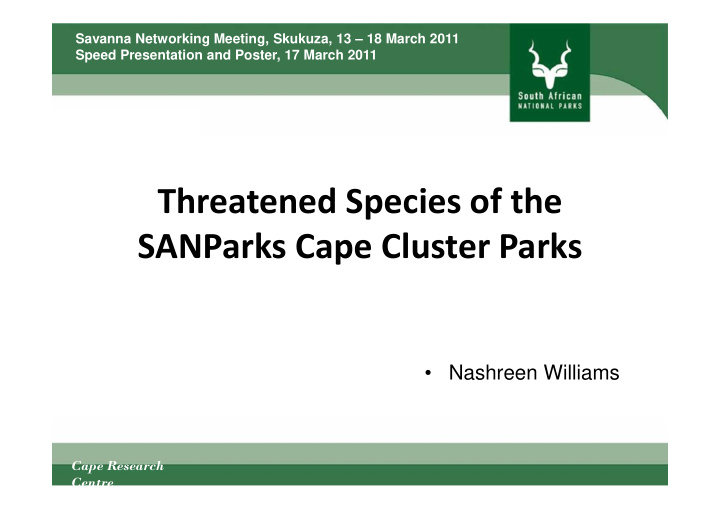



Savanna Networking Meeting, Skukuza, 13 – 18 March 2011 Speed Presentation and Poster, 17 March 2011 Threatened Species of the SANParks Cape Cluster Parks • Nashreen Williams �������������� ������
Conservation Value • The Cape Floristic Region (CFR) • approximately 9600 plant species on record • Of these plant species, ~75 % do not occur naturally anywhere else on earth The Cape Peninsula is home to • Diosma fallax – EN 3 ~180 threatened species, this Aspalathus burchelliana – EN 3 number includes six species that are currently listed as extinct • Sitting in the heart of the Peninsula is TMNP which is the largest section of natural land. Erica filamentosa – VU 3 Crytanthus leptosiphon – CR 3 Haworthia marginata – VU 3
Threats Bontebok National Park Acacia mearnsii - BNP In the Fynbos of the lowlands, alien invasive Acacia species accounted for 36% of the area transformed, with agriculture Acacia saligna - BNP and afforestation accounting for a further 49%
Threats By contrast, in the mountains, 26% of the area was transformed by Hakea and Pinus infestations and merely 7% by agriculture and afforestation Pinus radiata - Pine tree plantation in TMNP
Species of Special Concern Monitoring Programme Flow diagram of the four steps that constitutes the approach of the Species of Special Concern Monitoring Programme SANParks’ Framework for Biodiversity Monitoring guides the • structure and development of the Biodiversity Monitoring System (BMS) for SANParks 1 • The Species of Special Concern (SSC) monitoring programme is one of the ten selected programmes that make up the Biodiversity Monitoring System. Aimed at monitoring selected target species that have been • identified as a conservation priority for each relevant park. 1. McGeoch M. et. al. 2010 SANParks Biodiversity Monitoring Programme: Species of Special Concern, Unpublished.
Species of Special Concern Monitoring Programme Flow diagram of the four steps that constitutes the approach of the Species of Special Concern Monitoring Programme Identification and listing of SSC Prioritizing target SSC for monitoring 1 3 2 Disa uniflora - LC Disa longicornu - VU Erica verticillata - EW
Species of Special Concern Monitoring Programme Flow diagram of the four steps that constitutes the approach of the Species of Special Concern Monitoring Programme Identification and listing of SSC Prioritizing target SSC for monitoring Monitoring SSC Monitoring in the field – TMNP mountain Fynbos
Species of Special Concern Monitoring Programme Flow diagram of the four steps that constitutes the approach of the Species of Special Concern Monitoring Programme Identification and listing of SSC Prioritizing target SSC for monitoring 1. The number of species on the SSC list (albeit biased by data availability and collection effort). 2. The number of target SSC, i.e. how many Monitoring SSC are being monitored. 3. The type and number of threats to SSC 4. The conservation status of SSC 5. Number of target SSC for which Thresholds Indicators of Potential Concern have been breached. 6. Population sizes (or equivalent/alternative) of target SSC.
Indicators • Each of these indicators has strengths and weaknesses • However, until a comprehensive set of data on SSC are available for one and more parks with data for two (preferably three) points in time, it is not possible to test any of these indicators to assess their feasibility and usefulness in a SANParks context. • Therefore, this stage of the SSC-MP will be further developed in the next revision cycle.
Acknowledgments • The Andrew W. Mellon Foundation • WWF Table Mountain Fund • SANParks and Partner organizations Thank you
Recommend
More recommend